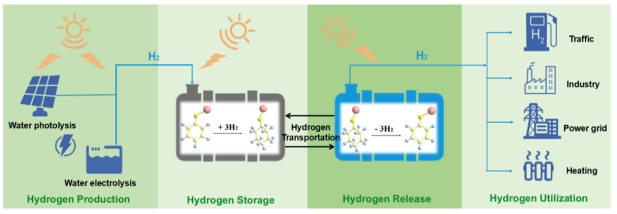Recently, Professor Chen Ping and Professor He Teng from our research group at the Dalian Institute of Chemical Physics, in collaboration with Associate Professor Rao Li from Central China Normal University, have made new progress in developing metal-organic compounds for hydrogen storage materials. For the first time, they utilized photocatalysis to achieve reversible hydrogenation and dehydrogenation cycles of these materials.
Hydrogen energy has the advantages of high energy density, abundant sources, and emission-free conversion, making it an ideal secondary energy source. However, the lack of safe and efficient storage carriers poses a significant challenge, hindering the large-scale application of hydrogen energy. In the quest to find adequate solutions, early on, our research group proposed a strategy to replace protic hydrogen atoms in organic materials with lightweight metals, leading to the development of a new type of hydrogen storage materials named metal-organic compounds (MOCs) (Angew. Chem. Int. Ed. 2019; Energy Storage Mater., 2020; J. Energy Chem., 2025), and overcoming the difficulty of achieving both high hydrogen storage capacity and ideal thermodynamics of dehydrogenation. Moreover, some of these metal-organic compounds have also been shown to be potential solid-state electrolytes with great application prospects in solid-state ion conduction for electrical energy storage (Angew. Chem. Int. Ed., 2023, Adv. Funct. Mater., 2024). However, for hydrogen storage applications, the dehydrogenation of metal-organic compounds requires breaking relatively strong C–H bonds and typically encounters a high kinetic energy barrier, thus necessitating the development of efficient catalytic systems and processes to achieve rapid hydrogen absorption and desorption under mild conditions.
In this work, the research team mainly studied a sodium phenoxide-sodium cyclohexanolate pair using solar energy to drive reversible hydrogen uptake and release. The study found that under light, Rh/TiO2 can effectively catalyze sodium phenoxide's hydrogenation and sodium cyclohexanolate's dehydrogenation, and most importantly, the dehydrogenation rate is nearly two orders of magnitude higher than the thermal catalytic process. In addition, the system also achieved high conversion and high selectivity of sodium cyclohexanolate to sodium phenolate under solar power. Experimental characterization and theoretical calculation results show that while the primary function of low-frequency light is to provide heat for the reaction, the high-frequency light is conducive for the desorption of sodium phenolate product, thereby achieving rapid dehydrogenation of sodium cyclohexanol under full spectrum.

These research findings were published in the scientific journal Angewandte Chemie International Edition under the title: "Solar-Driven Reversible Hydrogen Storage of Sodium Cyclohexanolate/Phenoxide Pair." The co-first authors of this study are Khai Chen Tan, a doctoral student in the DNL1901 group, and Pei Qijun, an Assistant Professor in the same group. This work was funded by the National Key R&D Program, the National Natural Science Foundation of China, and other projects (Text/Photo by Khai Chen Tan and Pei Qijun).
Article link:https://doi.org/10.1002/anie.202506275

 Home
>>
Highlights
Home
>>
Highlights